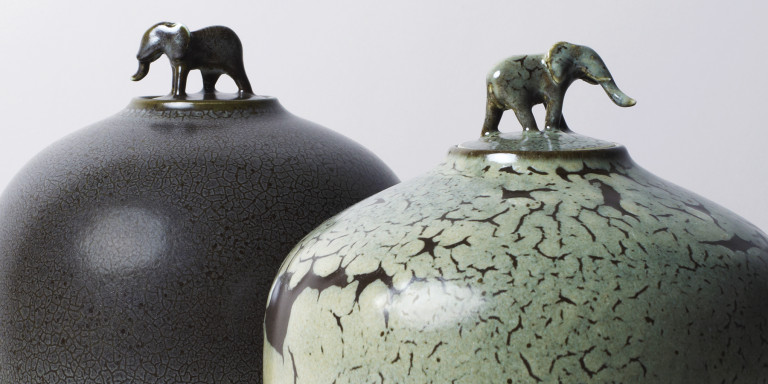
June 27, 2016Fanciful majolica earthenware is experiencing an uptick in popularity, especially when deployed in modern interiors. In his Bridgehampton, New York, home (above), architect Preston T. Phillips displays a collection of plates amid contemporary pieces, including a 1967 Andy Warhol print. Top: Many of Phillips’s foliage-themed wares bear the marks of the style’s most notable manufacturers, such as Minton and Wedgwood. Photos by Lesley Unruh, unless otherwise noted. Styling by Maren Romney
The popularity of Victorian majolica, the gaily colored, metallic-oxide-glazed earthenware, has ebbed and flowed for more than a century. Right now it appears to be having a moment — again. “I’ve seen majolica creeping back,” says Linda Horn, proprietor of an eponymous antiques shop on New York’s Madison Avenue and one of the largest majolica collectors in the United States. “People want colorful, fanciful pieces for juxtaposition in their modern or minimal environments.” These can include useful wares, like plates and pitchers, or decorative pieces, like life-size herons, crouching-blackamoor garden seats and freestanding fountains.
“The latest revival started about eight years ago,” concurs Susan Blatt, owner of Black-Eyed Susan’s Antiques, in Philadelphia, another big source for majolica. “It was when we started to see major collections going to the big auction houses,” like those of the Philadelphia philanthropist Michael Coslov and Pittsburgh billionaire Richard Mellon Scaife.
Starting in the 1850s, people in the U.S. and the U.K. embraced these affordable housewares with unusual polychrome palettes (turquoise and pink) and whimsical forms (candlesticks shaped like dolphins). By the 1870s, majolica was being mass-produced for an ever-expanding middle class in countries like England, France, Sweden, Hungary and Portugal. Majolica was Art for Everyman. Its popularity coincided with interest in exotic Japonisme and scientific studies by the likes of Carl Linnaeus, Charles Darwin and John James Audubon, explains Nicolaus Boston, a longtime majolica dealer, curator and author based in Ireland.
Despite a similarity in name, Victorian majolica is significantly different in subject matter and form from its Italian forebear, Renaissance maiolica. That earlier earthenware bore gaily painted religious and mythological scenes, and unlike majolica, with its lively contours, was not molded or three dimensional.

A pair of colorful Wedgwood majolica cachepots offered by Linda Horn is decorated with three-dimensional grapevines and busts of Bacchus as handles.
What was the attraction of majolica for the 19th-century collector? “Imagine what it looked like in a Victorian interior, with dark woods, heavy drapes and upholstered chairs and sofas,” says Susan Weber, founder of the Bard Graduate Center in New York. “Majolica is robust and extremely tactile. With its naturalistic shapes, colorful glazes and often humorous themes, it appealed to the growing consumer society.” (Weber is now preparing a museum exhibition on majolica at Bard for 2020.)
In 19th-century France, Sèvres and smaller ceramics firms began to reinterpret the snake-decorated platters made by Bernard Palissy, a 16th-century self-taught French potter. The result was a type of majolica called Palissy ware, which, like the originals, was festooned with odd creatures (lobsters, lizards and snakes) modeled by hand.
The late Moroccan-born, Paris-based decorator Alberto Pinto often placed Palissy ware in his clients’ living rooms, posing individual pieces on brackets against a background of stamped, gilded leather. Pinto, in turn, influenced such contemporary decorators as Harry Heissmann of New York.
“Like other forms of majolica, Palissy ware provides an instant curiosity cabinet,” Heissmann says. “It is imaginative, magical and mysterious. Any piece adds texture and character, whether you place a creature-strewn platter on a center table or masterfully arrange a grouping on the wall, as Pinto did.”
Susan Zises Green, another New York decorator, is an avid collector of majolica and uses it liberally on her dining table when she entertains. “I’ve collected majolica since I was twenty-six,” she says. “It makes me smile.” The 19th-century Portuguese ceramist Manuel Mafra gave his neo-Palissy majolica compositions even more drama, with snakes choking frogs, for example. “Majolica potters really went wild sometimes,” says Blatt, of Black-Eyed Susan’s. “They had a sense of humor.”

In Phillips’s home, a modern bar cart from the Swedish Pavilion of the 1939 World’s Fair is decorated with Majolica serveware, coasters from the Sunnylands estate in Palm Springs, California, and Waterford crystal glasses. The artwork is Robert Rauschenberg‘s American — Soviet Array II, 1988–89.
In England, manufacturers like Minton began to produce decorative, relief-molded majolica tiles for the interiors of taverns, train stations, even the famous Queen’s Dairy at Frogmore, on the grounds of Windsor Castle. (The Crown pub in Belfast has majolica tiles on the interior and exterior.) The most monumental figural work of majolica was probably Minton’s Saint George and the Dragon fountain, made for the London International Exhibition of 1862. It was 36 feet high and 39 feet in diameter, made of 379 individual pieces. Beneath George and the Dragon was a column adorned with four winged figures of Victory and a circle of heraldic lions spewing plumes of water. Below them were giant storks holding up seashell basins in which sea nymphs bathed. The water was perfumed, adding to the already rich sensory experience. Although Queen Victoria loved and promoted majolica, her grandson’s wife, Queen Mary, despised it. She called the Saint George fountain “hideous,” and it was destroyed in the 1920s.
Nonetheless, throughout the late 19th century, European majolica factories crafted wildly original pieces to promote themselves at world’s fairs held in London (1851 and 1862), Paris (1855) and Philadelphia (1876). As the influential textile and tile designer William Morris told residents of Staffordshire, England, in 1881, “You, who in these parts make such hard, smooth, well-compacted and enduring pottery, understand well that you must give it other qualities besides those which make it fit for ordinary use. You must profess to make it beautiful as well as useful, and if you did not, you would certainly lose your market.”
After 1900, people got swept up in the romanticism of Art Nouveau and ceased buying majolica. Did they have enough oyster plates and pineapple jugs in their cabinets? No one knows, but majolica fell out of fashion and began to be denigrated. (About a majolica-clad room at the Victoria & Albert Museum, Building News wrote in 1870: “This is but a sham art, just as they are sham columns — a casing of crockery built up around a brick core.”) By the 1920s, most of the old molds had been discarded.

A six-well majolica oyster plate, ca. 1890, by the French manufacturer Orchies is offered by Black-Eyed Susan’s Antiques.
The 1970s saw a revival of interest. “Why fashion happens makes no sense, but I see changes in taste kind of like waves,” says Jason Jacques, a dealer in Art Nouveau ceramics. “Majolica is definitely a little kitsch, which generally requires a good mood to deal with it. It’s not serious art. But you could say its warmth, whimsy and decoration were embraced as a turn away from the minimal, super-Zen, Bauhaus way of life. After 1950s modernism, we needed something else.”
Collectors today credit the pioneering London dealer Jeremy Cooper with reviving interest in majolica through the many exhibitions he organized in the 1970s (one of his customers was Linda Horn).
In 1982, the Cooper Hewitt, Smithsonian Design Museum, in New York, organized “English Majolica,” an exhibition featuring 75 examples from Minton, Wedgwood and George Jones, among other makers. Then, in 1984, Manhattan collectors Marilyn G. Karmason and Joan B. Stacke founded the Majolica International Society and published the first comprehensive reference book, Majolica: A Complete History and Illustrated Survey. And in 1990, the decorative arts specialist Nicholas M. Dawes, who is now with Heritage Auctions, wrote Majolica, a definitive guide to English, European and American manufacturers.
Armed with these books, new aficionados, like Phil and Deborah English of Baltimore, stepped into the field, becoming major collectors and contributors to the Majolica International Society. Deborah English is now the curator of the Karmason Library, a digital archive of some 10,000 pieces available to members of the society, and the Englishes will be hosting a tour of their collection during the annual convention of the society in Baltimore this August.

The verdant pieces in Phillips’s collection, accumulated over decades by a friend who left them to Phillips in his will, create a pleasing contrast when displayed on an Isamu Noguchi coffee table.
“I’ve seen majolica creeping back. People want colorful, fanciful pieces for juxtaposition in their modern or minimal environments,” says dealer Linda Horn.

An early-20th-century pine department-store counter holds a selection of majolica in Phillips’s home office. Lowell Nesbitt’s painting Purple & White Iris, 1980, reflects the pottery’s botanical theme.
When prices rose too high too quickly, interest in majolica began to wane yet again. But, as they say, that was then, and this is now. This past April, Nicolaus Boston hosted a seminar at the Bruce Museum, in Greenwich, Connecticut, With great humor, he chronicled how Herbert Minton lured talented French designers like Rodin’s teacher, Albert Ernest Carrier-Belleuse, to his factory because he wanted to produce the most artistic majolica in England. Boston also explained how appealing rural themes (fruits, flowers, game and fowl) were to people caught in cities polluted by the booming industrial revolution. Majolica brought the country — and summer — indoors.
These days, people collect majolica in every which way: by size, manufacturer, country of origin, date, pattern, style, type, subject, use and price. Some limit themselves to botanical pieces, while others tend to skew more figural.
For his part, Boston began collecting majolica at 18 and has seen prices rise and drop dramatically over the years. “There are so many different factories, shapes, dynasties,” he says. “Every collection has its own personality. Collecting majolica is the ultimate jigsaw puzzle.”





